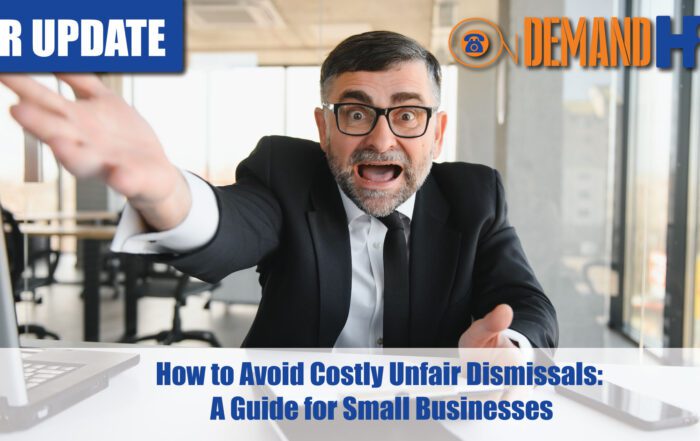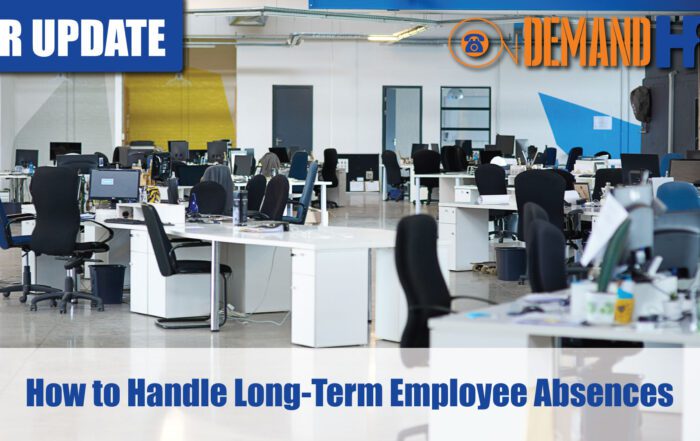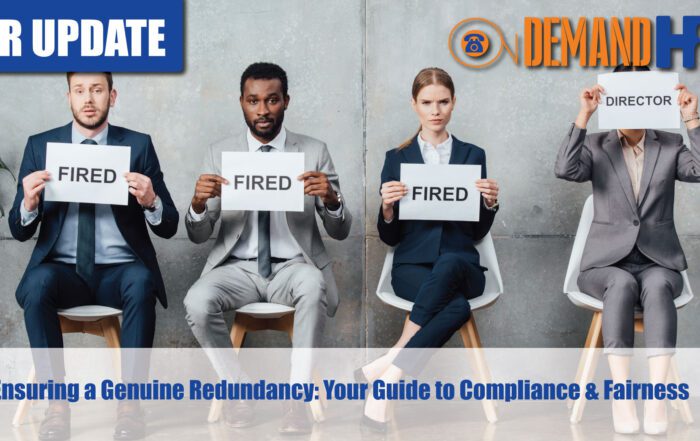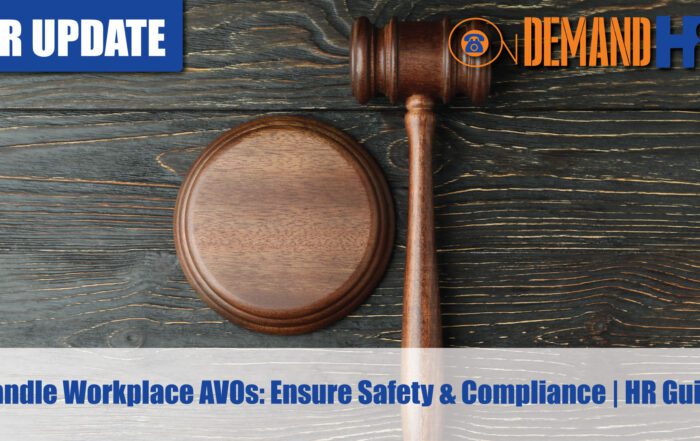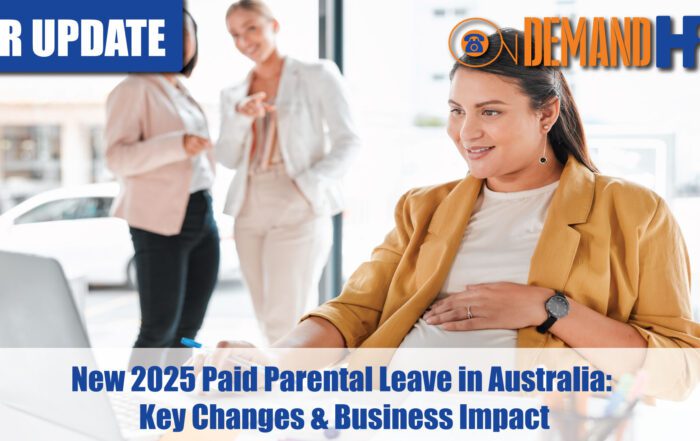Recent Floods & Important Employment Implications
Webinar replay covering the 2021 NSW floods and discussing some of the resulting employment implications. Topics covered in this session include:
- Standing down employees without pay as a result of the recent floods;
- Situations where you may be trading through the recent flood,
- but employees can’t get to work; Employees are available to work, but it is not safe to do so;
- Other options for providing alternative duties; Redundancy provisions of the Fair Work Act;
- Answer any questions or specific scenarios facing your business.
Please see below for a full transcript of the video.
Share the HR or workplace relations challenge facing your business and one of our experienced consultants will be in touch within 24 hours with a strategic action plan or discover the best strategy yourself by accessing out free online training library.
Transcript
0:00
For those who don’t know me, my name is Clint Indrele. I am the managing director of On Demand HR. On Demand HR has been providing Workplace Relations advice to clients now, for best part of 11 years. We have a dedicated team of consultants, primarily based in Sydney. We do also have some contracting arrangements outside of Sydney to assist clients. But we’ve got a team now of six of us. So yeah, we’re certainly growing in the significant demand for services has meant that we’ve had to put more consultants on board and attend to, you know, clients as they need. We’ve worked with about 450 businesses over the past 11 years. And certainly, we’ve covered a very wide range of industries over that particular period of time.
So we might get started on today’s session, and look, if anyone wants to join in throughout, obviously, they can jump onto the presentation as we go. So today’s presentation will be about recent floods, and the important employment considerations. Obviously, we’ll go through today’s session, and if anyone’s got any questions and answers, please put them in the q&a box. I’ll continue to monitor that as we go through the session. Okay, without further ado, let’s get started. So I’m going to everyone should be able to see the presentation here.
And I want to start with just a little bit of introduction on you know, sort of the status quo of things and the effects of the floods, broadly speaking. So we can see at the moment that obviously, it’s a significant flood event, there’s been about 12,500 requests for help and about 1000 rescues, the worst impacted areas seem to have a bit of a diverse mix of businesses, a number of which include agricultural businesses. Obviously, these floods presents significant challenge for challenges for managing employees with a period of time for recovery. So that is some of the stuff that we’ll get into today and look at some of the strategies around how we can assist businesses in that recovery and in managing their employment affairs. Today, we’re going to really cover some of the common challenges and some of the common questions we’ve had in particularly the last seven days, and share some of that advice that we’ve already been giving to businesses as they’ve been requesting it. Again, we’re putting on this webinar really as a way of helping businesses just understand some strategies and to give them some information to take away from it. If you just take the information away and use it to the best of your ability, that that’s great. And we hopefully you can all get something out of it. For those who are looking for a bit more hand holding and some formal advice to assist with this stuff. Obviously, we’re available to help you with that. But we really wanted to put this webinar on as a way of just helping the community and a way of helping businesses who are struggling with these particular times. As I said, we’ll take any questions live. And again, also happy to offer some free initial advice regarding your specific scenarios via phone. So I’m just going to quickly check our attendees list. Before I get into the first slide, see, we have a few more attendees joining which is fantastic.
So okay, so I’m going to start with talking about the entire business or division shut down. So this is part of the Fair Work Act section 524, and 525. So let’s just talk about the scenarios where a business can stand down employees. So an employer may stand down an employee during a period in which the employee cannot usefully be employed, because of a number of circumstances, including industrial action, other than industrial action organized or engaged by the employer, a breakdown of machinery or equipment, if the employer cannot be held responsible for the breakdown, or reasonably responsible for the breakdown, or, and this is the third one, which we’re relying on for the purposes of this discussion, a stoppage of work for any cause for which the employer cannot reasonably be held responsible.
Now, it’s so interesting that over the past 11 years of doing Workplace Relations consulting, we’ve hardly ever called on the stand down provisions of the Fair Work Act. But in the last, probably 15 to 16 months, we’ve called on it the best part of three or four times because we’ve had fires, we’ve had floods, we’ve had COVID-19, and now we’ve got more floods. So it’s really interesting that it’s just been a crazy 15 or 16 months in Workplace Relations. And these stand down provisions obviously, were designed for this particular type of situation, but they’re just never used for so long. And now we’re seeing a situation where they’re being used frequently in that period in the last as I said last year and a bit.
So, I want to be clear on situations where a business can stand down its employees when we mean stand down employees it’s the ability for an employer to direct an employee to basically, they have no work for them to perform. And for them not to be paid for that particular period, we’ll get into situations where there can be payments made. But the stand down principle at a high level is that you can stand down employees in that they’re not coming to work, and they’re not being paid for not coming to work.
So let’s talk about those situations where employees can be stood down and situations where they can’t. So if the business is not trading in any capacity as a result of the floods, then that most likely would be a stand down situation, or if a specific division of the business is unable to trade as a result of the flood. So if your product or service or area, specifically, and the and the services or products that you provide, are specifically impacted, and employees can’t be usefully employed, because of these floods, then ultimately, there there is, there is the potential for a stand down to occur in those situations
Situations, however, where a stand down may not occur, such as these, so where employees can’t get to work, because of their location, and the business continues to trade. That’s not a stand down situation, or if a business or division can continue to trade, but their trading terms have deteriorated as a result of the floods. Now, that’s a fine line in that situation. Because, you know, where do you draw the line between the business can’t trade at all versus they can trade but with deteriorating terms, and we had this with COVID-19 a lot as well, where businesses that were affected by COVID-19 had a reduction in their business, but they weren’t actually prevented from trading. And let me give you a classic COVID-19 stand down situation. And maybe we can try and relate it back to floods.
So when the government shut down certain employment activities, such as, for example, people couldn’t go into shops, restaurants, or conduct certain types of outdoor activities. If your business was directly involved in any of those activities, those would have been pretty close to black and white stand down situations where they’re much more gray and much more difficult is where there wasn’t necessarily the government’s direction to stop those activities. The business could still trade, but the trading terms deteriorated. So trying to relate this back to a flood situation, I think that if the flooding results in your business, completely stopping. So if for example, you’re operating a turf farm, and your whole turf farm, you know, cannot be used for the purposes of normal trading, then that’s a more black and white stand down situation, if you have some of your product affected, but not other parts of your product, that might be a more difficult situation. Because theoretically, there could be an ability to trade, but it might be on a reduced footing. So that’s the more complicated scenario and depends on how the business is structured, depends on how its divisionalized, and those sorts of things. So let’s not get confused between complete stoppage and perhaps partial stoppage. And that’s where the whole divisionalising part can come into it.
And I will say this, that in 2020, we saw a lot of businesses, really, I guess, probably acting on the edge of this part of the Fair Work Act, because what they would do is they would just make the argument that we could stand down employees as a result of COVID-19. And the situation at the time was quite dire and so difficult that businesses I thought just took the punt a lot with going with the stand down even if, you know it may not have been completely 100% legitimate to do so. So I think that there may be situations where employees might have to take risks in these situations, they may have to decide the stand down employees even if it’s not 100% in accordance with, you know, the act and the case law and how that how that looks. So I hope that’s a little bit of background as to what we’ll get into further in the presentation today. And again, please shoot me any questions as we go through the session.
So what is the process then of standing down employees? so some key and fundamental things that need to be thought about? So first of all, the direction must be in writing. So if you’re standing down employees the direction to stand down those employees must be in writing, okay? Now that’s different from a situation where employees have agreed to takeperhaps annual leave for a period of time until the business can reassess the situation. If employees have agreed to take annual leave we’d probably just recommend that you have that annual leave obviously agreed in writing in some particular way but we’re talking about here stand down where there’s no payment being made and where the people are being essentially, or the employees being sent home unpaid so to speak.
An interesting question and something we debated amongst ourselves here at On Demand HR is whether or not consultation is required. Now what we mean by consultation is that each modern award has what is called a consultation clause and consultation is required under the award in various different situations it’s normally required in redundancy situations so for example if we are downsizing our business and that there’s going to be employment impacts as a result of that that is a clear cut black and white consultation requirement. However is consultation required when we’re standing down employees under the under the fair work act under section 524? We actually had some some pretty strong debate on this my take and this was disagreeing with one of my colleagues was that i don’t believe consultation is required unless you have an enterprise agreement which stipulates that it is. Modern awards generally talk about permanent changes to structure, program organization, those sorts of things and I don’t see a stand down as being that. Could consultation be required because of changes to the hours of work potentially. But at the moment we think that that a stand down direction can simply be given without consultation.
Ultimately the other the other question here is that would consultation really impact on the decision anyway? probably not. Except for obviously people having the option to go on to leave which we would always recommend employers consider then that would be the only thing that really you’d be consulting about so to speak. So check if you’ve got an enterprise agreement in place obviously you should know whether you’ve got an enterprise agreement in place but i’m going to assume for the purposes of today’s discussions that most of you would not have an enterprise agreement in place and therefore it would only be the modern award and therefore consultation is not necessarily required. And when we mean consultation, obviously continue to talk to your employees but the formal definition of consultation as outlined in the modern award.
So what happens if employees are stood down? So the first option you’ve got is obviously to have or part of the stand down period replaced by annual leave or rostered ndays off. So that isn’t an option or alternative to stand down or something that can work in conjunction with the stand down. Again you could use long service leave or even potentially pro rata long service leave so if you’ve got employees that have between five and 10 years service and you know that otherwise would be going without pay, what you might agree with those employees is that they potentially can access some of that pro rata long service leave particularly if we think that you know that they’re going to be with us for a few more years and that’s a that’s an entitlement that were fall during the future anyway.
So technically employees are not entitled prior rather long service leave after five years it’s only if they’ve resigned in certain circumstances or if they are terminated in certain circumstances. So, but ultimately the the the default position for a stand down is unpaid unpaid leave or it’s not really unpaid leave it’s an unpaid stand down so to speak. So essentially unless the employee agrees to annual leave or rostered days off unless they agreed to long service leave or pro rata long service leave the stand down is unpaid.
It is important to note however and this is what i want all businesses to think about is that i want you to try and think about how long you might be out of action for, or your business might be out of action for as a result of these floods. And remember that accruals continue to operate as normal as if the stand down did not occur okay so to put that in practical terms if you were to be if your employees were stood down for a period of three months you would be required to continue to accrue annual leave and long service leave as normal and sick leave and you know in three months effectively all employees would accrue an extra week of annual leave. So the unpaid stand down does not stop the normal accrual of leave for employees so that’s that’s an important distinction because sometimes in unpaid leave situations whether it’s parental leave or other agreed unpaid leave the accruals do stop in a stand down situation they don’t stop they continue to accrue. So i hope that gives everyone a bit of an understanding or insight as to what may be needed in a stand down situation in terms of leave how it occurs and what things should be considered. So as we said the default position is that the employee takes paid leave and or unpaid leave.
There is a question mark however around section 97 of the Fair Work Act. And that is that generally with personal leave, everyone is familiar with personal leave being that the employee can take sick what’s called sick leave essentially, or personal leave is just another name for sick leave, they can take sick leave in situations where an employee is either ill or injured themselves, or they have to care or support for someone in their immediate Family or Household because they are sick or ill or because of an unexpected emergency. So it will be interesting to see whether or not any employees play the unexpected emergency card. And whether or not there is any valid basis for employees using sick leave during this particular period. Now, if the employees are already stood down, then effectively, we would argue that well, no sick leave is applicable. Because ultimately, they were not required to come to work anyway. And so that’s why I’m saying that, you know, we can pay annual leave, we can pay long service leave by agreement, but ultimately, once a person is stood down, there are no hours of work for that person to work. And therefore, if they fall sick in that period, I would argue that they’re not entitled to sick leave. Or if they have an emergency during that period, they’re not entitled, because ultimately, the sick leave doesn’t replace any work that they would have been required to do. So that’s an interesting and looked quite quite complex concept to get your head around. But ultimately, there’s a number of situations where we can prevent any sick leave requests during this particular period.
Obviously, look, this is an opportunity to reduce leave liabilities throughout this period. And, you know, certainly that for businesses that have the funds to do that, that should be certainly the default position. Is looking to use leave to sustain employees during this period. And to cover that.
Just got a question here. from Michelle, thank you for asking it. An employee is called to serve the SES or RFS, during a weather event, how should this be treated? So this is a really good question. Michelle, this goes to actually the community service leave that’s under the NES and under the NES employees have the right to take community service leave, I’m just going to check whether that is paid or unpaid leave just I’ve just had a bit of a brain fade actually on on that. So I’m just going to check the NES on that particular front and see what that says. It’s going to see what it says in respect to community service leavr. So let’s take that one. Right now. Community Service leave. It’s going to go to it here. See, it would definitely fall in the bucket of community service leave Michelle, that’s the first thing. So that covers things like voluntary emergency management, covers jury duty. So I’m just having a look at it again here, Yeah, it’s unpaid, with the exception of jury duty. So jury duty, there is payments associated with that. And it’s unpaid if it’s any other form of community service leave. So again, Michelle, obviously, they can take annual leave instead of that unpaid leave. I don’t believe it would be personal leave because it’s not. It’s not illness or injury. It’s not caring for a person who’s ill, or injured or unexpected emergency. It’s certainly in the community service leave bucket, which means it’s unpaid. And yes, they could take annual leave instead by agreement. So that’s, that’s, that’s ultimately I hope that answered your questions, I’m pretty confident with that resolution, and that being the path in those situations.
So the other thing that businesses can think about doing, especially where employees can’t get to work, is they can be directed to work alternative duties as well. So for example if employees can’t get to work because of the location or because of, you know, they can’t drive to a particular area, or it’s not reasonable practical to get for them to get from one place to another. They can be redirected to work or general duties, what those alternative duties might be is perhaps difficult to anticipate. But that is another thing that probably was more in play last week when the floodwaters were quite high. Whereas some employees were saying that they couldn’t, they could not get to the work location, I would imagine that a lot of those requests are probably faded in the last week, unless of course there are particular roads that are completely shut down or blocked off from people getting through. So I’d be very interested to hear if anyone’s got any employees that still can’t get to work when they’re still trading is normal. So if anyone’s got a situation like that, let us know. Otherwise, I’ll leave that situation where it is.
So these are the strategies I guess for businesses to look at where employees can’t get to work. So the default position is they either take paid leave, or unpaid leave. Hopefully, they don’t use personal leave. If we’re still trading, there could be an argument. As I said if it fits that unexpected emergency where another person in the in the household or family has that, as I said, opportunity to reduce leave liabilities, mutual unpaid leave is other option can be directed to work alternative duties so that that’s a bit a bit about employees who can’t get to work.
I want to engage in a bit more thinking though deeper thinking beyond just the here and now in terms of redundant in terms of sorry, stand downs, and employees can’t get to work and those sorts of things and the temporary measures. I want businesses to have also think about the permanent and ongoing measures. Okay. So I think there is an opportunity here for businesses to be strategic. So if businesses think that as a result of these floods, it is clear that there needs to be a permanent reduction to their workforce on an ongoing basis. This is not a bad time to think about that and think about executing that. Okay. So first and foremost, if we’re standing down employees right now. And if we also are going through some sort of redundancy process, we could potentially do the two at the same time. And what we could actually do is we can actually avoid, potentially notice provisions, because we’re standing down employees during the notice period. So that is one option that’s available.
There is a number of process steps around redundancies, because there is consultation required, we have to provide information prior to a decision, and so on. So there is a number of obligations, and I’ll talk about that in a number of my other redundancy sessions that I presented in previously. The good news is for most businesses under 15 employees, you are exempt from redundancy payments. Under the NES, when we mean redundancy payments, we mean the redundancy pay component. Now, businesses are still required to provide notice in accordance with the National Employment Standards, but not the redundancy pay. The good news and what I checked before today’s session is that the nursery award 2020, which covers a number of turf farmers does not have any special small business redundancy pay provisions. So most modern awards don’t have any special redundancy pay provisions. But there are some awards like the timber industry award, the textiles award and those sorts of things that will have special small business redundancy provisions. Okay. The good news is the nursery award doesn’t. So ultimately no redundancy pay if you’ve got less than 15 employees, it’s only the issue of dealing with the notice. Okay. Now, and this might also coincide with you coming off job keeper as well, because many businesses are just feeling that pinch this week as well.
Got another question. I have a related question. In relation to vaccinations for COVID-19. That’s fine. We’ll take this in this session. Where vaccination for COVID-19 is required by our clients before entering their sites and an employee refuses to have one and cannot work. How can this be dealt with? So this is interesting, because I think it’s a question of, there’s probably two issues here. If the vaccination is required by the client for the purposes of meeting a government requirement, or if the client is going out on a limb, so to speak, by requesting its contractors and employees to have vaccinations in circumstances where it’s not mandatory to do so. My I’ll get to this in stages I’m going to layer this explanation in. So I think the first principle is that, and this is what I’ve been saying to clients is I don’t see any sense why clients would go above the government requirements on COVID-19. If the government says you must vaccinate your employees in this particular industry or this particular occupation, well, obviously you’ve got no choice and to do it. If the government doesn’t tell you to do it, I would say at this point, don’t don’t make any employment based requirements for that to happen.
Now, obviously, in your situation here. Michelle, you’re describing a situation where a client has taken this position of which might be government it might not be government directed. If the employer refuses to have one and cannot work, how can this be dealt with? So it’s a very difficult situation. There is actually a case last year where a childcare center required its employees to vaccinate for the flu an employee refused to have that flu vaccination. And as a result of that she was actually terminated from her employment the matter went to the Fair Work Commission.
It’s actually a shame the matter didn’t go to hearing because it would have given us a very clear direction on this. But what actually happened is that the case was dismissed, because the applicant applicant filed out of time. Now, that’s because she filed after the 21 days. So that’s a shame, because that would have been a good test of this particular issue. But what the commissioner did say about that is that both sides of the argument were arguable. And what that’s saying to us, and what some people are suggesting is that that will open it up for employers to require certain vaccinations in these situations. So in short, if an employee can’t, can’t, for example, or is not prepared to take a vaccination or and or be vaccinated, and the clients that that person works with, require that. And that person can’t be usefully put in another role. It may be the case that the person can no longer perform the inherent requirements of the job.
And like an injury situation where you might terminate someone after a long term injury because they can’t do the inherent requirements of the job. This could be a similar situation. So I don’t want to say definitively whether it’s a yes or a no, and it does, it does depend on the specific circumstances. But ultimately, that is something that could lead to termination of employment, it could certainly be discussed and considered. And you may undertake a process regarding that, and you may want to consider that position. The only thing I would say on that is that I don’t know if that’s the clients policy now or if that’s a client’s intended policy for the future, because there’s many obviously people in the in the Australian in the Australian population, that don’t even have access to this vaccine yet. So how can they be vaccinated yet when they don’t even have access yet? Obviously, we’re going through the various stages Yeah, exactly. Is it even if it isn’t even a legitimate policy to have at this particular point in time? How can a person be vaccinated when various different sectors of the population may not have even reached that phase yet? Yeah, and then there’s other there’s other issues around discrimination and other political objections or things like that, as well. So very good question. Very thought provoking. So we’ll just have to see. We just have to see how that plays out. But assuming that at some point, the person could get access to that vaccination, then yes, it is possible that a, a inherent requirements based termination could be considered.
Back to restructuring and redundancies. The other thing I wanted to outline for those businesses here or people on here that have clients that have more than 15 employees, and might be required to pay redundancy pay. There is also a situation here where section 120 of the Fair Work Act actually allows businesses to claim financial hardship and apply for a reduction to redundancy pay to the Fair Work Commission. So this is for businesses that have 15 or more employees. And there was actually a case in 2020 with Mason Architectural Joinery, where they actually had the redundancy pay entitlement reduced from seven weeks to one week, because of the impacts of COVID-19 on their business. So it’s very, very interesting, because that business argued the impact of COVID-19 you know, justified them reducing the amount of redundancy pay that they paid to employees, reducing it from seven weeks to one week. And the commission took the view that the sustaining of the remaining employees was more important than paying someone else redundancy pay, which is very interesting. It’s almost like they’re choosing between the kind of the past and the present employees, they would rather sustain, the employees still left in the business thenactually pay additional redundancy paid to the person. That’s that’s been exited from the business as a result of a restructure. So that’s something to remember, if you are looking to implement a number of redundancies, and you have more than 15 employees. So that is a worthwhile point.
Look, that is ultimately all I really wanted to cover today in the webinar. I know that today’s a fairly short webinar, it’s got a fairly narrow and a specific focus. But look, if you’ve got any further questions regarding these matters, I will be on the line for another two, three minutes to answer those. But you may also reach out to any of us here at On Demand HR, you can send through an email at any time to advice@ondemandhr.com.au we’re quite happy to offer you some initial free advice on how to handle these issues. If you really want some more detailed hand holding and those sort of things we could talk about, obviously, what that would involve at a later time.
But we really want to just share with you some thoughts around how to manage these situations, given the situation the crisis that we have for some businesses. So I hope that you’ve learned something from today’s session. For those who aren’t subscribed onto our onto our distribution list, we’d recommend that certainly you you join that because we do present some excellent content throughout the year and webinars that you may very well be interested in. So, yeah, look, there’s going to be a great number of great opportunities to come on, learn more about Workplace Relations, learn more about the Fair Work Act, learn more about the various developments in Workplace Relations. And there’s been a hell of a lot of these in the last 15 months. So thanks so much for your attendance today. Thank you very much for your questions. As I said, If anyone’s got any last questions for the group session, if you can, please ask for the next 30 seconds, that would be great. Otherwise, I will wrap this session up shortly. Once again. For those as I said, who don’t know me, my name is Clint Indrele, Managing Director of On Demand HR, on demand HR remains committed to obviously offering businesses of all shapes and sizes, you know, advice on Workplace Relations situations as they need.
I do have another question. So I will take it before we end up finishing the seminar. Do you know how it works as far as paying people when they are on a disaster allowance? Yeah, look, we are not actually ofay with the disaster allowance yet and how that specifically works, whether that’s an employment based payment, or whether that’s some sort of subsidy for the business. In respect to that I haven’t been following the disaster allowance that closely. Michelle, but it’s a good question. I’m not sure. Obviously, when you think about job keeper, job keeper is ultimately a payment that was made to employers, but directly as a direct subsidy for employee wages. So I don’t know if the disaster allowance operates in a similar manner to job keeper. Or if it operates as some sort of business payment as such, and I’ll just refer to your your follow up comment is a replacement for job seeker. Because they’re still employed. Okay, well, I’ll be very interested to know more about that disaster allowance. And I will certainly have one of our consulting team learn more about how that might work in conjunction with normal payments, and how that might work in conjunction with a stand down how that might work in conjunction with normal work resuming. So we’re not i’m not i’m not ofay with the eligibility on that yet. So I appreciate you bringing that to our attention. And obviously, we will, we will continue to advise with that in mind. So yeah, I’ll certainly ask one of our consultants to take a closer look at that disaster allowance now and and give some thoughts on how that will work in conjunction with stand downs, how that will work in conjunction with paid leave, or how that works in conjunction with normal trading. So thanks very much for that question and comment Michelle, much appreciated.
If there’s no other questions, then we might wrap up shortly. So look, thanks very much for your time. I’m sorry, you’ve got one more question here, which I will take. So this is just around, you’re saying Michelle that you’re getting different answers from CentreLink? You can find out that would be good as employees could end up with a tax debt at the end of the year. Yeah, that would be good to know. I mean, obviously, job job keeper, if you like was based on it being an employment payment, or subsidizing wages, so to speak which was facilitated by the employer. So if the disaster allowance works similarly, I mean, I imagine it would be a taxable payment. But as I said, I have I haven’t gone into the detail of the disaster allowance yet. And we’ll find out about that in in due course. So thank you for bringing that to our attention, Michelle, and we’ll certainly examine that more closely.
Thanks very much, once again for your attendance. Thank you for continuing to support On Demand HR and its various different activities that we do in terms of webinars. As I said, if anyone else would like to know more about this, please reach out to us at advice@ondemandhr.com.au for me, Clint Indrele, and my facilitator for today, Andrew Koleda operations manager. It’s bye for now and enjoy your Easter and the long weekend.

